contenttypes 是Django内置的一个应用,可以追踪项目中所有app和model的对应关系,并记录在ContentType表中。
1.创建一个项目

2.数据库迁移,生成默认表。

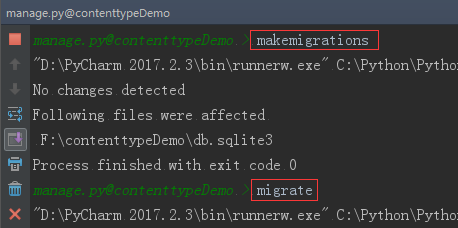
3.存着所有app的名字、表名字。

每当我们创建了新的model并执行数据库迁移后,ContentType表中就会自动新增一条记录。比如我在应用app01的models.py中创建表class Electrics(models.Model): pass。从数据库查看ContentType表,显示如下:
| id | app_label | model |
|---|---|---|
| … | admin, auth等内置应用… | … |
| 5 | contenttypes | contenttype |
| 6 | app01 | electrics |
那么这个表有什么作用呢?这里提供一个场景,网上商城购物时,会有各种各样的优惠券,比如通用优惠券,满减券,或者是仅限特定品类的优惠券。在数据库中,可以通过外键将优惠券和不同品类的商品表关联起来:
from django.db import models class Electrics(models.Model): """ id name 1 日立冰箱 2 三星电视 3 小天鹅洗衣机 """ name = models.CharField(max_length=32) class Foods(models.Model): """ id name 1 面包 2 烤鸭 """ name = models.CharField(max_length=32) class Clothes(models.Model): name = models.CharField(max_length=32) class Coupon(models.Model): # 特殊关系表
"""
id name electric_id food_id cloth_id more... # 每增加一张表,关系表的结构就要多加一个字段。
1 通用优惠券 null null null
2 冰箱满减券 2 null null
3 面包狂欢节 null 1 null
"""
name = models.CharField(max_length=32)
electric = models.ForeignKey(to='Electrics', null=True)
food = models.ForeignKey(to='Foods', null=True)
cloth = models.ForeignKey(to='Clothes', null=True)
如果是通用优惠券,那么所有的ForeignKey为null,如果仅限某些商品,那么对应商品ForeignKey记录该商品的id,不相关的记录为null。但是这样做是有问题的:实际中商品品类繁多,而且很可能还会持续增加,那么优惠券表中的外键将越来越多,但是每条记录仅使用其中的一个或某几个外键字段。
contenttypes 应用
通过使用contenttypes 应用中提供的特殊字段GenericForeignKey,我们可以很好的解决这个问题。只需要以下三步:
- 在model中定义ForeignKey字段,并关联到ContentType表。通常这个字段命名为“content_type”
- 在model中定义PositiveIntegerField字段,用来存储关联表中的主键。通常这个字段命名为“object_id”
- 在model中定义GenericForeignKey字段,传入上述两个字段的名字。
为了更方便查询商品的优惠券,我们还可以在商品类中通过GenericRelation字段定义反向关系。
示例代码:
from django.db import models from django.contrib.contenttypes.models import ContentType from django.contrib.contenttypes.fields import GenericForeignKey,GenericRelation class Electrics(models.Model): name = models.CharField(max_length=32) price = models.IntegerField(default=100) coupons = GenericRelation(to='Coupon') def __str__(self): return self.name class Foods(models.Model): name = models.CharField(max_length=32) price=models.IntegerField(default=100) coupons = GenericRelation(to='Coupon') def __str__(self): return self.name class Clothes(models.Model): name = models.CharField(max_length=32) price = models.IntegerField(default=100) coupons = GenericRelation(to='Coupon') def __str__(self): return self.name class bed(models.Model): name = models.CharField(max_length=32) price = models.IntegerField(default=100) coupons = GenericRelation(to='Coupon') class Coupon(models.Model): """ Coupon id name content_type_id object_id_id 1 美的满减优惠券 9(电器表electrics) 3 2 猪蹄买一送一优惠券 10 2 3 南极被子买200减50优惠券 11 1 """ name = models.CharField(max_length=32) content_type = models.ForeignKey(to=ContentType) # step 1 object_id = models.PositiveIntegerField() # step 2 content_object = GenericForeignKey('content_type', 'object_id') # step 3 def __str__(self): return self.name
注意:ContentType只运用于1对多的关系!!!并且多的那张表中有多个ForeignKey字段。
4.数据化迁移,再给每张表添加数据。
4.1.衣服表。
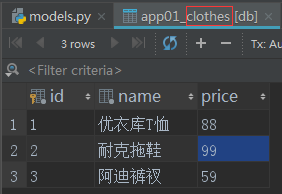
4.2.电器表。

4.3.食物表。
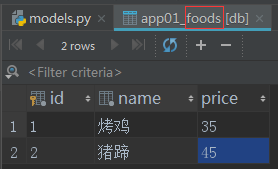
4.4.django_content_type表。

5.再加一张表(床上用品表),数据迁移后,添加几条数据。
class bed(models.Model): name = models.CharField(max_length=32) coupons = GenericRelation(to='Coupon')
5.1床上用品表
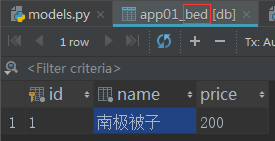
创建记录和查询
from django.shortcuts import render, HttpResponse from app01 import models from django.contrib.contenttypes.models import ContentType def test(request): if request.method == 'GET': # ContentType表对象有model_class() 方法,取到对应model content = ContentType.objects.filter(app_label='app01', model='electrics').first() # 表名小写 cloth_class = content.model_class() # cloth_class 就相当于models.Electrics res = cloth_class.objects.all() print(res) # 为三星电视(id=2)创建一条优惠记录 s_tv = models.Electrics.objects.filter(id=2).first() models.Coupon.objects.create(name='电视优惠券', content_object=s_tv) # 查询优惠券(id=1)绑定了哪个商品 coupon_obj = models.Coupon.objects.filter(id=1).first() prod = coupon_obj.content_object print(prod) # 查询三星电视(id=2)的所有优惠券 res = s_tv.coupons.all() print(res) # 查询obj的所有优惠券:如果没有定义反向查询字段,通过如下方式: content = ContentType.objects.filter(app_label='app01', model='model_name').first() res = models.OftenAskedQuestion.objects.filter(content_type=content, object_id=obj.pk).all() return HttpResponse('....')
总结:
当一张表和多个表FK关联,并且多个FK中只能选择其中一个或其中n个时,可以利用contenttypes app,只需定义三个字段就搞定!
创建记录
关系表的结构

注意:直接用表加,object_id写不了。

6.用语法给关系表加记录。
6.1添加方式1:
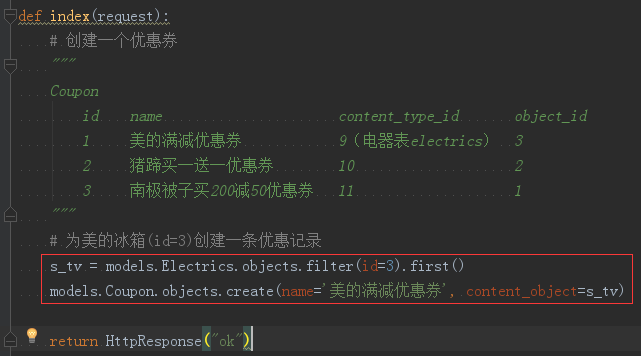

查看关系表记录

6.2添加方式2:
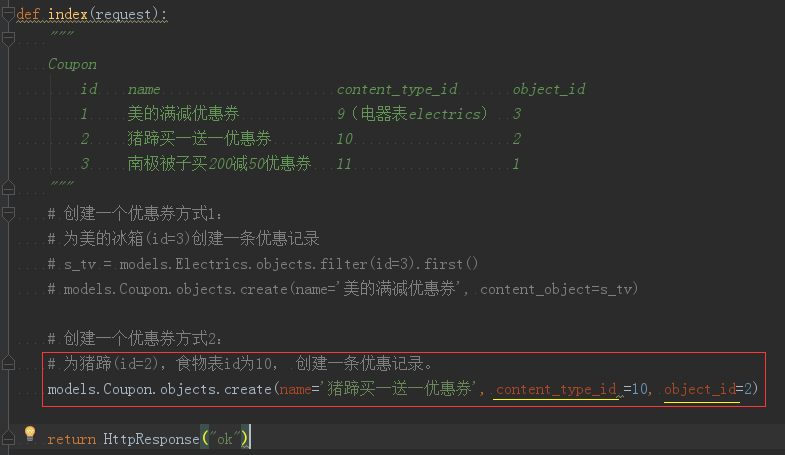
查看关系表记录

代码:
from django.shortcuts import render,HttpResponse # Create your views here. from app01 import models def index(request): """ Coupon id name content_type_id object_id 1 美的满减优惠券 9(电器表electrics) 3 2 猪蹄买一送一优惠券 10 2 3 南极被子买200减50优惠券 11 1 """ # 创建一个优惠券方式1: # 为美的冰箱(id=3)创建一条优惠记录 # s_tv = models.Electrics.objects.filter(id=3).first() # models.Coupon.objects.create(name='美的满减优惠券', content_object=s_tv) # 创建一个优惠券方式2: # 为猪蹄(id=2),食物表id为10, 创建一条优惠记录。 models.Coupon.objects.create(name='猪蹄买一送一优惠券', content_type_id =10, object_id=2) return HttpResponse("ok")
查询记录
7.查询‘猪蹄买一送一优惠券’对应商品的价格。
from app01 import models coupon = models.Coupon.objects.filter(name="猪蹄买一送一优惠券").first() coupon <Coupon: 猪蹄买一送一优惠券> coupon.content_type <ContentType: foods> coupon.content_type.model 'foods' coupon.object_id 2 coupon.content_type.model_class() <class 'app01.models.Foods'> coupon.content_type.model_class().objects.filter(pk=coupon.object_id) <QuerySet [<Foods: 猪蹄>]> coupon.content_type.model_class().objects.filter(pk=coupon.object_id).first().price coupon.content_object <Foods: 猪蹄> coupon.content_object.price
45




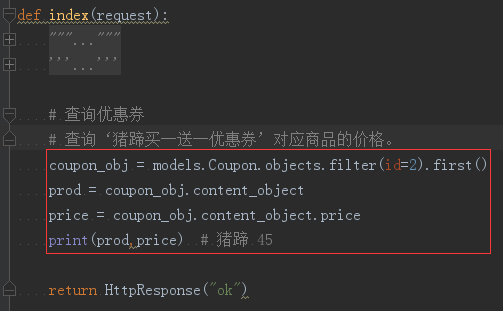

from django.shortcuts import render,HttpResponse # Create your views here. from app01 import models def index(request): """ Coupon id name content_type_id object_id 1 美的满减优惠券 9(电器表electrics) 3 2 猪蹄买一送一优惠券 10 2 3 南极被子买200减50优惠券 11 1 """ ''' #添加优惠券 # 创建一个优惠券方式1: # 为美的冰箱(id=3)创建一条优惠记录 # s_tv = models.Electrics.objects.filter(id=3).first() # models.Coupon.objects.create(name='美的满减优惠券', content_object=s_tv) # 创建一个优惠券方式2: # 为猪蹄(id=2),食物表id为10, 创建一条优惠记录。 models.Coupon.objects.create(name='猪蹄买一送一优惠券', content_type_id =10, object_id=2) ''' # 查询优惠券 ''' # 查询‘猪蹄买一送一优惠券’对应商品的价格。 coupon_obj = models.Coupon.objects.filter(id=2).first() prod = coupon_obj.content_object price = coupon_obj.content_object.price print(prod,price) # 猪蹄 45 ''' # 美的冰箱所有的优惠券 return HttpResponse("ok")
8.美的冰箱所有的优惠券

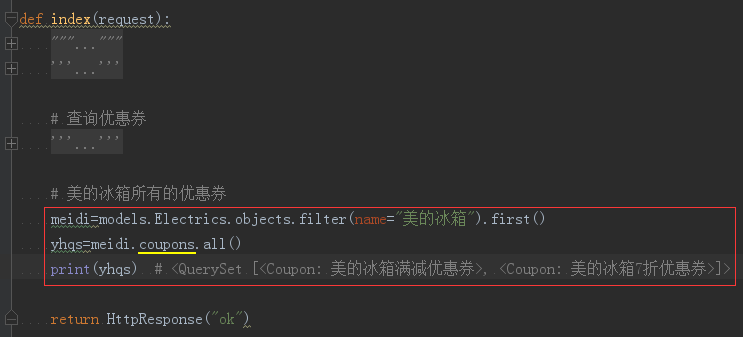

from django.shortcuts import render,HttpResponse # Create your views here. from app01 import models def index(request): """ Coupon id name content_type_id object_id 1 美的满减优惠券 9(电器表electrics) 3 2 猪蹄买一送一优惠券 10 2 3 南极被子买200减50优惠券 11 1 """ ''' #添加优惠券 # 创建一个优惠券方式1: # 为美的冰箱(id=3)创建一条优惠记录 # s_tv = models.Electrics.objects.filter(id=3).first() # models.Coupon.objects.create(name='美的满减优惠券', content_object=s_tv) # 创建一个优惠券方式2: # 为猪蹄(id=2),食物表id为10, 创建一条优惠记录。 models.Coupon.objects.create(name='猪蹄买一送一优惠券', content_type_id =10, object_id=2) ''' # 查询优惠券 ''' # 查询‘猪蹄买一送一优惠券’对应商品的价格。 coupon_obj = models.Coupon.objects.filter(id=2).first() prod = coupon_obj.content_object price = coupon_obj.content_object.price print(prod,price) # 猪蹄 45 ''' # 美的冰箱所有的优惠券 meidi=models.Electrics.objects.filter(name="美的冰箱").first() yhqs=meidi.coupons.all() print(yhqs) # <QuerySet [<Coupon: 美的冰箱满减优惠券>, <Coupon: 美的冰箱7折优惠券>]> return HttpResponse("ok")
路飞学城类似的表关系

course(专题课程) id name id name 1 flasky源码 degree(学位课程) id name id name 1 python全栈开发 Price strategy(价格策略) id price period course_id degree_id id price period course_id degree_id 1 100 1周 1 2 200 4周 1 3 600 9周 1 OftenQuestion # 问题表 id title course_id degree_id id title course_id degree_id 1 flask怎么下载 1 2 flask文档如何去读 1
